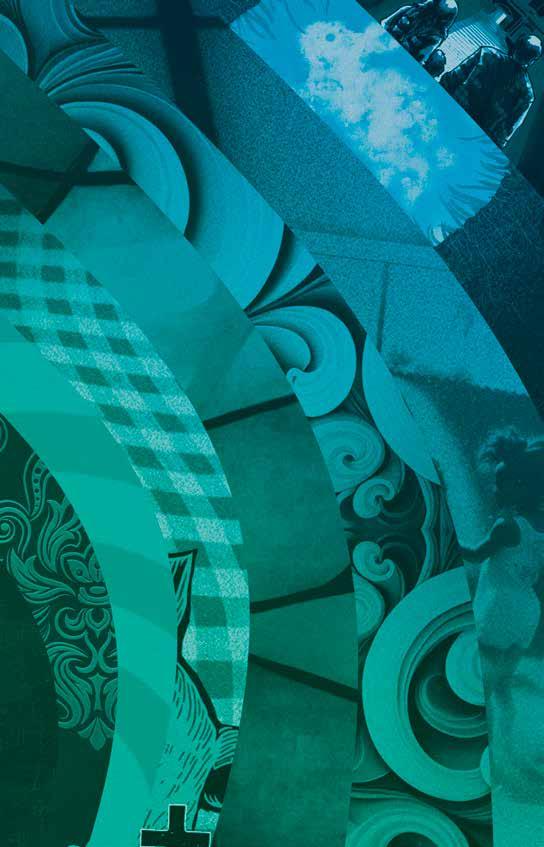
4 minute read
THE MAGIC IS IN THE MOVEMENT
An Interview with Camille Labarre, Puppet Designer for Water for Elephants
STORY BY Olivia Aston Bosworth & Kay Nilest
What is your earliest memory of building a puppet?
My earliest puppet must have been a model of the human arm for my middle school science class which my father and I built out of plexiglass in his workshop. I didn’t really find puppetry until adulthood. That said, a lot of the media we consumed as kids did involve live-action or stop-motion puppetry — Jim Henson, Aardman, Gumby, Shari Lewis, Tim Burton, etc. That was definitely my mother’s influence. Now, of her three daughters, two are puppet makers and one is an animator. Thanks, Mom!
Have you always wanted to be a maker in theatre?
Theater was a big part of my cultural awareness growing up thanks to my grandfather. He took us to see shows and made sure we knew all the classics. While I never intended to work in theater, I can’t say I’m totally surprised. I thought I wanted to be an art teacher — it seemed like a rewarding career that would allow me to continue making things. I quickly learned that finding a decent job was going to be really, really hard — welcome to being a millennial! So, I swallowed my pride and did an internship making stop motion puppets and props for an animation company in Soho. That job was a revelation — I enjoyed the work, I was very good at it, and I saw a career open up to me that I didn’t know existed. Once I started freelancing, all the stop motion gigs had moved to Portland, so I pivoted to stage and TV puppets and the rest is history. Today, I run my own puppet and prop shop with my sister Rose called LAB LAB, and that’s where all the puppets in Water for Elephants were made.
What excites you about puppetry? On the flip side, does anything scare you about working in this medium? Puppetry is just animation in real time. My sister Natalie, who is an animator, is naturally a very skilled puppeteer because the basic principle for both mediums is the same: The magic of illusion through movement. The most thrilling part of the process for me is the same as when I worked in stop motion — seeing your puppets come to life. All the care and attention that goes into making a puppet is in service of that movement, without which it wouldn’t be a puppet. I’m not a puppeteer — but it’s an art form that I deeply respect. The more I work with puppetry, the better I understand that my role as puppet designer is secondary to that of the puppeteer. Now, I do believe that good puppet design elevates the overall effect of the performance, but without a good puppeteer, a well-designed puppet is just a beautiful object. The magic is in the movement.
What is your typical process for designing a puppet?
I like to use Procreate on my iPad — I’ve never been all that tech savvy and it’s easy to use. The first step to designing is to ask a lot of questions — we all have different ways of describing what we see in our heads, so I need to make sure we’re speaking the same visual language. Once I get a sense of the overall look of the project and how it needs to perform, I’m able to suggest a set of options for the direction for the puppet. As soon as one of the sketches gets approved, we can start building. A lot of design decisions are made in the process of taking a theoretical 2D rendering and turning it into a practical 3D object. The builder actually does a lot of design work that almost always goes uncredited. That’s why I’m always sure to give design credit to my head builders and to do a lot of the building myself. The most joyful part of the process for me is in the building of puppets and of a community of people I choose to work beside every day.
Now, the elephant: How many hours has your team spent on this one puppet? Lucky for you, I’m very organized! Rosie has taken our team of 4-6 just under 1,800 hours to complete since October. I was very lucky to have assembled my dream team to make Rosie come to life, so I’d like to shout out my Head Builders: Rose Labarre (Associate Puppet Designer), Sierra Schoening (Assistant Puppet Designer), and Kenneth Rainey (Assistant Puppet Designer), without whom Rosie would not be the stunning elephant that she is today.
Any words of advice for aspiring designers and makers in Atlanta?
I recently watched a video about Orissa Kelly who is a foot archer — a gymnast who stands on her hands and shoots arrows with her feet. She figured that she didn’t have to be the best gymnast in the world to make a living — she just had to be the best foot archer. So, she practiced her craft for 6 months until she could hit the bullseye effortlessly. Today, she makes a great living shooting arrows with her feet. Two important lessons can be learned from Orissa about survival in the arts: to be very disciplined about your curiosity and to carve a niche for yourself to shine. That’s an actionable way to set yourself up for success.

MIKE SCHLEIFER
Managing Director
CHRISTOPHER MOSES
Dan Reardon Director of Education & Associate Artistic Director
TINASHE KAJESE-BOLDEN BOLD Associate Artistic Director
BASED ON THE NOVEL BY SARA GRUEN PROJECTIONS
CASTING
TARA RUBIN CASTING
CLAIRE BURKE, CSA JODY FELDMAN
MUSIC SUPERVISION & ARRANGEMENTS
MARY-MITCHELL CAMPBELL & BENEDICT BRAXTON-SMITH
CHOREOGRAPHY




